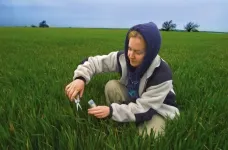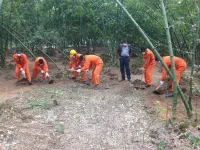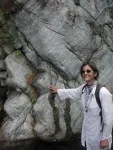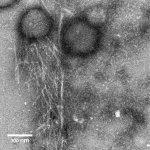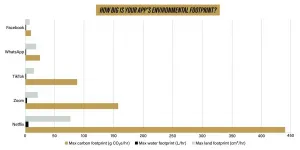INFORMATION:
About the article
The article "Dominant Reaction Pathways by Quantum Computing" was written for the scientific journal "Physical Review Letters" by Giovanni Mattiotti, Philipp Hauke and Pietro Faccioli. Giovanni Mattiotti is now a doctoral student at the Physics Department of the University of Trento, while Philipp Hauke and Pietro Faccioli are associate professors at the same department.
Quantum computers to study the functioning of the molecules of life
A team of theoretical physicists from the University of Trento has shown that it is possible to use quantum computers to simulate processes of great biological importance, such as changes in the shape of proteins
2021-01-14
(Press-News.org) The human body is like a construction site where hundreds of thousands of different molecular nanomachines, called proteins, are simultaneously at work. Each one of these biomolecules, which are chains of amino acids essential to living organisms, perform a different biological function, often in synergy with other proteins. During their formation (the folding process) or in the performance of their biological functions, proteins change their shape in a very specific way. In many cases it is possible to conduct experiments that provide images of proteins at near atomic resolution, but only when they are in the stable and biologically active form. The dynamic processes associated with changes in shape are still largely unknown. Understanding these mechanisms and predicting the behavior of proteins is a fundamental step, for example, to develop advanced medical treatments for old and new diseases, from the most studied (like cancer and degenerative diseases) to emerging ones (Covid-19), to rare diseases.
Great strides have been made in recent decades in the study of processes involving structural changes in proteins, using computer simulations. Now, quantum computers are a powerful tool for carrying out even more precise and complete observations, as demonstrated by the study conducted by a group of physicists of the University of Trento that appeared in Physical Review Letters, one of the most prestigious physics journals that has been published by the American Physical Society since 1958.
"For the first time, we demonstrate that quantum computers can be used to understand at near atomic detail the functioning of biomolecules", explains Pietro Faccioli, author of the scientific article together with colleague Philipp Hauke and student Giovanni Mattiotti. Using this technology, the researchers of the Physics Department of the University of Trento have developed a method to compute changes in protein shape and trajectory. A breakthrough that has implications for molecular biology, pharmacology and nanotechnologies.
The fields of application are many. Identifying the mechanisms behind neurodegenerative processes in some proteins, for example, can help limit their proliferation. Understanding how a protein takes on a certain shape can open the way to use the nanomachines that nature has designed to cut, edit or block damaged or defective genes.
"We reformulated the mathematical problem underlying the predictions of structure changes as an optimization problem", underlines Pietro Faccioli. "Quantum computers are particularly suitable for solving optimization problems because they exploit a fascinating phenomenon known as quantum delocalization, which is only found in the microscopic world," adds Philipp Hauke.
ELSE PRESS RELEASES FROM THIS DATE:
The role of T cells in fighting cancer
2021-01-14
New research from CU Cancer Center member Jing Hong Wang, MD, PhD, and recent University of Colorado Immunology program graduate Rachel Woolaver, PhD, may help researchers develop more effective personalized immunotherapy for cancer patients.
Working within Wang's specialty of cancer immunology and head and neck squamous cell carcinomas (HNSCCs), the researchers worked to establish a mouse model that would help them understand why some hosts' immune systems reject tumors easily, while others have a harder time doing so. Their research was published last week in the Journal for ImmunoTherapy of Cancer.
"It's particularly interesting now because the field of cancer treatment has really been going in the direction of immunotherapy, ...
Exposure to violence takes a toll on the socioemotional well-being of Californians
2021-01-14
Researchers at the UC Davis Violence Prevention Research Program (VPRP) assessed the prevalence of exposure to violence, such as robbery or assault, and its impacts on the mental health and social functioning of California adults. Their study, published in the Journal of Interpersonal Violence, shows the far-reaching psychological effects an incident of gun violence can have on victims and those close to them.
The study's findings are based on data from 2,558 adults who responded to the 2018 California Safety and Wellbeing Survey (CSaWS). CSaWS is an ongoing survey research project on firearm ownership and the consequences of exposure to violence in California. Responses were weighted to be statistically representative of the state's adult population.
These ...
Berkeley Lab science snapshots
2021-01-14
Primer on Carbon Dioxide Removal Provides Vital Resource at Critical Time
--By Julie Chao
Scientists say that any serious plan to address climate change should include carbon dioxide removal (CDR) technologies and policies, which makes the newly launched CDR Primer an especially vital resource, says Berkeley Lab scientist Margaret Torn, one of about three dozen scientists who contributed to this document.
"Atmospheric CO2 concentrations are already 50% over historic natural levels - 270 ppm (parts per million) in pre-industrial times vs 414 ppm today," said Torn. "To slow climate change and avoid its worst impacts, climate scientists tell ...
Population density and virus strains will affect how regions can resume normal life
2021-01-14
MADISON, Wis. -- As a new, apparently more transmissible version of the virus that causes COVID-19 has appeared in several countries, new research finds that the transmissibility of viral strains and the population density of a region will play big roles in how vaccination campaigns can help towns and cities return to more normal activities.
The findings suggest that directing vaccines toward densely populated counties would help to interrupt transmission of the disease. Current vaccination distribution plans don't take density into account.
Tony Ives at the University of Wisconsin-Madison and Claudio Bozzuto of the independent data research company Wildlife ...
Following the hops of disordered proteins could lead to future treatments of Alzheimer's disease
2021-01-14
Researchers from the University of Cambridge, the University of Milan and Google Research have used machine learning techniques to predict how proteins, particularly those implicated in neurological diseases, completely change their shapes in a matter of microseconds.
They found that when amyloid beta, a key protein implicated in Alzheimer's disease, adopts a highly disordered shape, it actually becomes less likely to stick together and form the toxic clusters which lead to the death of brain cells.
The results, reported in the journal Nature Computational Science, could aid in the future development of treatments ...
Lead poisoning of children
2021-01-14
Decades after the industrialized world largely eliminated lead poisoning in children, the potent neurotoxin still lurks in one in three children globally. A new study in Bangladesh by researchers at Stanford University and other institutions finds that a relatively affordable remediation process can almost entirely remove lead left behind by unregulated battery recycling - an industry responsible for much of the lead soil contamination in poor and middle-income countries - and raises troubling questions about how to effectively eliminate the poison from children's bodies.
"Once the lead is in the environment, it stays there pretty much indefinitely ...
Stretching more effective than walking to lower high blood pressure: USask study
2021-01-14
A new University of Saskatchewan (USask) study has found that stretching is superior to brisk walking for reducing blood pressure in people with high blood pressure or who are at risk of developing elevated blood pressure levels.
Walking has long been the prescription of choice for physicians trying to help their patients bring down their blood pressure. High blood pressure (hypertension) is a leading risk factor for cardiovascular disease and among the top preventable risk factors affecting overall mortality.
This new finding, published December 18, 2020 in the Journal of Physical Activity ...
Geologic history written in garnet sand
2021-01-14
On a beach on a remote island in eastern Papua New Guinea, a country located in the southwestern Pacific to the north of Australia, garnet sand reveals an important geologic discovery. Similar to messages in bottles that have traveled across the oceans, sediments derived from the erosion of rocks carry information from another time and place. In this case the grains of garnet sand reveal a story of traveling from the surface to deep into the Earth (~75 miles), and then returning to the surface before ending up on a beach as sand grains. Over the course of this geologic journey, the rock type changed as some minerals were changed, and other materials were included (trapped) within the newly formed garnets. The story is preserved ...
Toadlet peptide transforms into a deadly weapon against bacteria
2021-01-14
An antibacterial peptide that turns on and off
The researchers solved the 3D molecular structure of an antibacterial peptide named uperin 3.5, which is secreted on the skin of the Australian toadlet (Uperoleia mjobergii) as part of its immune system. They found that the peptide self-assembles into a unique fibrous structure, which via a sophisticated structural adaptation mechanism can change its form in the presence of bacteria to protect the toadlet from infections. This provides unique atomic-level evidence explaining a regulation mechanism of an antimicrobial ...
Turn off that camera during virtual meetings, environmental study says
2021-01-14
WEST LAFAYETTE, Ind. -- It's not just to hide clutter anymore - add "saving the planet" to the reasons you leave the camera off during your next virtual meeting.
A new study says that despite a record drop in global carbon emissions in 2020, a pandemic-driven shift to remote work and more at-home entertainment still presents significant environmental impact due to how internet data is stored and transferred around the world.
Just one hour of videoconferencing or streaming, for example, emits 150-1,000 grams of carbon dioxide (a gallon of gasoline burned from a car emits about 8,887 grams), requires 2-12 liters of water and demands a land area adding up to about the size of an iPad Mini.
But leaving your camera off during a web call can ...
LAST 30 PRESS RELEASES:
Azacitidine–venetoclax combination outperforms standard care in acute myeloid leukemia patients eligible for intensive chemotherapy
Adding epcoritamab to standard second-line therapy improves follicular lymphoma outcomes
New findings support a chemo-free approach for treating Ph+ ALL
Non-covalent btki pirtobrutinib shows promise as frontline therapy for CLL/SLL
University of Cincinnati experts present research at annual hematology event
ASH 2025: Antibody therapy eradicates traces of multiple myeloma in preliminary trial
ASH 2025: AI uncovers how DNA architecture failures trigger blood cancer
ASH 2025: New study shows that patients can safely receive stem cell transplants from mismatched, unrelated donors
Protective regimen allows successful stem cell transplant even without close genetic match between donor and recipient
Continuous and fixed-duration treatments result in similar outcomes for CLL
Measurable residual disease shows strong potential as an early indicator of survival in patients with acute myeloid leukemia
Chemotherapy and radiation are comparable as pre-transplant conditioning for patients with b-acute lymphoblastic leukemia who have no measurable residual disease
Roughly one-third of families with children being treated for leukemia struggle to pay living expenses
Quality improvement project results in increased screening and treatment for iron deficiency in pregnancy
IV iron improves survival, increases hemoglobin in hospitalized patients with iron-deficiency anemia and an acute infection
Black patients with acute myeloid leukemia are younger at diagnosis and experience poorer survival outcomes than White patients
Emergency departments fall short on delivering timely treatment for sickle cell pain
Study shows no clear evidence of harm from hydroxyurea use during pregnancy
Long-term outlook is positive for most after hematopoietic cell transplant for sickle cell disease
Study offers real-world data on commercial implementation of gene therapies for sickle cell disease and beta thalassemia
Early results suggest exa-cel gene therapy works well in children
NTIDE: Disability employment holds steady after data hiatus
Social lives of viruses affect antiviral resistance
Dose of psilocybin, dash of rabies point to treatment for depression
Helping health care providers navigate social, political, and legal barriers to patient care
Barrow Neurological Institute, University of Calgary study urges “major change” to migraine treatment in Emergency Departments
Using smartphones to improve disaster search and rescue
Robust new photocatalyst paves the way for cleaner hydrogen peroxide production and greener chemical manufacturing
Ultrafast material captures toxic PFAS at record speed and capacity
Plant phenolic acids supercharge old antibiotics against multidrug resistant E. coli
[Press-News.org] Quantum computers to study the functioning of the molecules of lifeA team of theoretical physicists from the University of Trento has shown that it is possible to use quantum computers to simulate processes of great biological importance, such as changes in the shape of proteins
